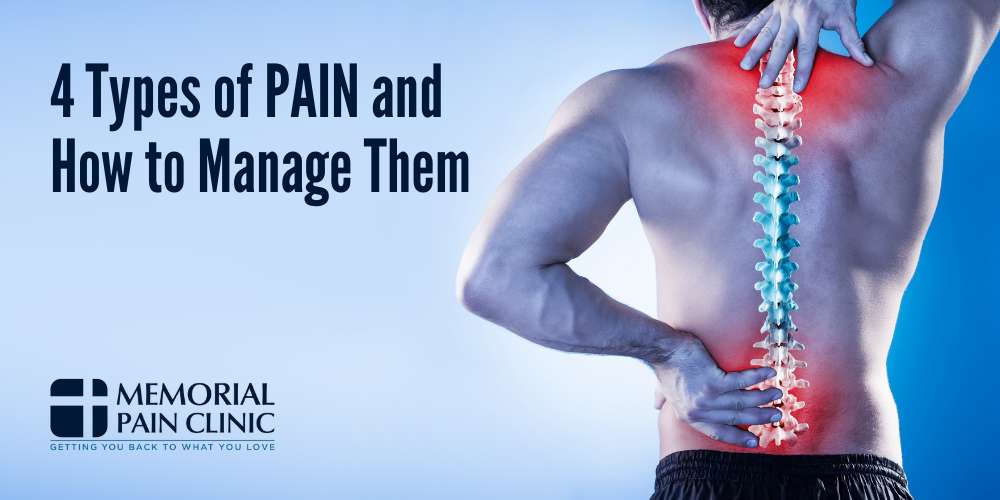From acute and chronic pain to neuropathic and nociceptive pain, each type of pain affects the nervous system, sending pain signals through the spinal cord and peripheral nerves, often causing nerve pain, muscle pain, joint pain, or visceral pain deep within internal organs. Exploring these 4 types of pain and how to manage them can help patients recognize the underlying cause. Identifying the right treatment, including pain medicine or surgery, supports better pain management, reduces anxiety, depression, and stress, and improves overall quality of life.
At Memorial Pain Clinic, compassionate doctors specialize in chronic pain management, tailoring high-quality pain management treatments in Tulsa to each patient’s unique symptoms. Call (918) 200-9944 today to schedule your appointment.
What Are the 4 Main Types of Pain?
Different types of pain affect the body. Understanding these can help you find the right treatment. Pain may be due to a recent injury or an underlying cause that has persisted for more than six months.
The four main types of pain are chronic pain, acute pain, nociceptive pain, and neuropathic pain. Each type of pain affects your body and mind differently, influencing both your quality of life and how you respond to pain management treatments. Whether you are experiencing shooting pain that comes from nerve damage or a simple short term pain episode, identifying the type of pain you have can guide you toward better options.
Different types of pain reflect the way your nervous system processes pain signals. For example, some pain is caused by tissue damage, while other pain stems from nerve pain within peripheral nerves or the brain. Understanding these pain types makes you take an important step toward finding relief.
1. Chronic Pain
Chronic pain is a type of pain that persists longer than what is considered a normal response to an injury or tissue injury. Chronic pain lasts longer than a simple acute episode, often continuing for more than six months. This lingering discomfort can lead to anxiety, depression, and reduced quality of life if not addressed.
People with chronic pain in Tulsa often experience a range of symptoms. Sometimes, it may start from an old broken bone or be related to conditions such as arthritis. Chronic pain may also be influenced by stress or emotional factors. This can leave patients feeling frustrated and unable to perform everyday tasks without discomfort.
Managing chronic pain often involves pain management techniques that include pain medicine, physical therapies, and sometimes surgery. By focusing on underlying cause factors, a doctor can help patients find strategies that reduce their discomfort and make daily activities more manageable.
2. Acute Pain
Another common type is acute pain. It usually begins suddenly and can result from a recent injury, such as a sprained ankle or a broken bone. Unlike chronic discomfort, acute pain often resolves as your body heals. Acute conditions can happen after shoulder pain from lifting something heavy or neck pain from sleeping awkwardly.
Acute pain is a normal response intended to protect you from potential harm. It sends signals through nerves and the spinal cord to alert your brain that something is wrong. For instance, touching a hot stove produces an immediate, sharp sensation that encourages you to withdraw your hand and prevent tissue damage.
In many cases, treating acute pain can involve simple pain relievers, rest, and targeted treatments. Because acute discomfort is short-term pain, patients often recover fully. Still, it is important to seek medical attention if the pain persists or worsens, as it may indicate a more serious injury that needs further evaluation.
3. Nociceptive Pain
Nociceptive pain is pain caused by actual or potential harm to the body’s tissues. It arises when pain receptors in your muscles, bones, or internal organs detect tissue damage. For example, broken bones or arthritis can produce nociceptive discomfort. This is a common type of discomfort associated with normal healing processes.
Somatic nociceptive pain affects structures such as bones, joints, and muscles. Muscle pain or joint pain can often fall under nociceptive pain. This type of pain often feels like a dull, aching sensation. On the other hand, visceral pain, another form of nociceptive pain, is linked to internal organs and may cause cramping or pressure-like feelings.
Treating nociceptive pain usually involves pain medicine, physical therapy, and other supportive methods. Because it stems from clear tissue injury, addressing the underlying cause can bring meaningful improvements.
4. Neuropathic Pain
Neuropathic pain stems from nerve damage or irritation within the nervous system. In conditions like trigeminal neuralgia or peripheral neuropathy, abnormal electrical signals travel through the peripheral nerves and the central nervous system, causing burning, tingling, or shooting pain sensations.
Neuropathic discomfort differs from nociceptive pain because it arises from nerve damage rather than direct tissue injury. This might happen after surgery or be related to conditions like radicular pain when irritated nerve roots in the spinal cord region generate pain signals. Neuropathic discomfort can be severe and persistent, often interfering with daily life.
In Tulsa, neuropathic pain treatment may involve pain relievers specifically designed for nerve pain, as well as certain therapies that calm irritated nerves. A doctor may recommend treatments like nerve blocks or other specialized interventions to restore comfort and function.
Other Types of Pain

Beyond the four main categories, other types of pain emerge from various factors. Some stem from specific injury patterns, while others, like psychogenic pain, link to anxiety or depression. Breakthrough pain occurs when chronic pain flares beyond normal levels, and all these types of pain influence patient experiences.
Recognizing different types of pain helps patients describe their discomfort more accurately to their doctor, making it easier to find effective pain management treatments that improve quality of life.
Radicular Pain
Radicular pain occurs when nerves coming from the spinal cord are compressed or irritated. This can cause shooting pain along the path of the affected nerve, sometimes accompanied by other symptoms like numbness or tingling. Radicular pain often radiates into the arms or legs, affecting normal activities.
Conditions like herniated discs or spinal stenosis can lead to radicular discomfort. Treating radicular pain might involve physical therapy, pain medicine, and sometimes medical attention if the injury is severe.
Addressing radicular pain early can prevent worsening discomfort and improve quality of life. With the right treatment, many patients find relief and return to daily activities.
Visceral Pain
Visceral pain comes from your internal organs. It can feel like a deep ache, pressure, or cramping sensation. Conditions involving the stomach, kidneys, or other internal organs may trigger visceral pain. This discomfort may be diffuse and harder to pinpoint.
Visceral discomfort can arise from tissue damage within organs or from problems like gallstones. Because internal organs do not have as many pain receptors as external tissues, visceral pain may feel different and be more challenging to explain.
Treating visceral pain often involves addressing the underlying cause. Pain management may include medications, dietary changes, or further evaluation.
Somatic Pain
Somatic pain affects bones, joints, muscles, and other connective tissues. Conditions like arthritis, a broken bone, or muscle strain can lead to somatic discomfort. It can feel sharp or aching and is often influenced by movement or pressure.
Somatic nociceptive pain is a common form of discomfort that often responds well to standard pain management methods, such as pain relievers or gentle exercises. Identifying the injured area can help pinpoint the cause of the pain and guide treatment.
Speaking with a doctor can help find practical solutions when somatic pain interferes with daily life. Physical therapy, proper rest, and targeted exercises can improve movement and reduce discomfort.
Diffuse Pain
Diffuse pain is a more generalized sensation that can spread throughout larger areas of the body. It might feel difficult to pinpoint exactly where it starts. Diffuse discomfort may occur with conditions like fibromyalgia or other widespread pain disorders.
Patients with diffuse discomfort may also experience fatigue, anxiety, or depression. Addressing these other symptoms can help in managing overall discomfort. A combination of strategies may be needed to restore well-being.
How Does Your Type of Pain Affect Your Pain Management Plan?

Identifying whether you have acute and chronic pain, neuropathic pain, or nociceptive pain helps guide pain management. Each type of pain has distinct features. A doctor can recommend targeted therapies by understanding pain caused by nerve damage or persistent visceral pain from internal organs.
If your discomfort involves nerve pain, specific treatments may help. For persistent visceral pain, addressing the underlying cause is key. Matching the treatment to your pain type can produce meaningful results.
What Are the Most Common Forms of Pain Management?
Pain management often involves approaches designed to address discomfort, enhance mobility, and improve quality of life. Common forms of care include:
- Medications and pain relievers that provide immediate relief
- Physical therapy exercises that restore movement and reduce tension
- Injections that target specific areas of discomfort
Advanced pain management may incorporate nerve blocks, spinal cord stimulation, or other techniques to adjust how the nervous system processes pain signals. For some patients, these methods offer pain relief even when other treatments are ineffective.
How Can a Pain Management Specialist Help You?
A pain management specialist can help you by:
- Identifying strategies tailored to your specific type of discomfort, whether due to peripheral neuropathy, radicular pain, or psychogenic pain
- Offering guidance that addresses both physical symptoms and emotional factors, such as anxiety and depression
- Improving overall quality of life by providing support, treatment, and encouragement to move forward with greater confidence
Schedule an Appointment at Memorial Pain Clinic in Tulsa, Ok Today

If you are experiencing persistent neck pain, shoulder pain, joint pain, or any severe discomfort that affects your daily routine, consider seeking medical attention. The Memorial Pain Clinic in Tulsa, OK, is ready to help you find relief and improve your quality of life.
Our patients benefit from a combination of pain management treatments designed to reduce discomfort, address underlying causes, and help them return to the activities they enjoy. Whether you have acute pain from a recent injury or chronic pain that has persisted, our team is dedicated to helping you feel better.
Contact us today at (918) 200-9944 to schedule an appointment with a doctor at Memorial Pain Clinic. Our goal is to guide you toward a more comfortable future, free from the limitations that pain causes.


